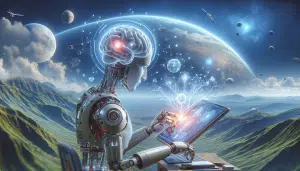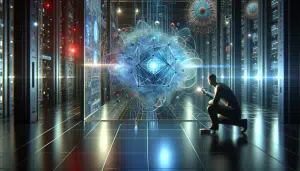Surprising Ways Artificial Intelligence Impacts You
Ethan Harris September 25, 2025
Artificial intelligence is shaping countless areas of life, often in invisible yet powerful ways. This guide explores how AI transforms health, careers, science, and beyond—giving you insight into its real-world effects and future potential.
Understanding Artificial Intelligence: More Than Just Robots
Artificial intelligence, or AI, forms the foundation for many of the breakthroughs that define today’s digital landscape. While it’s easy to imagine robots and science fiction, the reality is far more integrated and nuanced. AI consists of machines or systems able to perform complex tasks that generally require human intelligence, such as speech recognition, learning, planning, and problem-solving. The science driving AI draws from computer science, mathematics, statistics, and cognitive science, making it a multidisciplinary field with a wide impact. AI and machine learning are revolutionizing how people interact with both technology and each other, including everything from smart devices to search algorithms.
The rise of AI is powered by accessible data and high-speed computing power. What sets modern AI apart is its ability to analyze and learn from huge volumes of data. It recognizes patterns, makes predictions, and suggests solutions with increasing precision. Most people engage with AI daily, using voice assistants, translation apps, or personalized content recommendations. The scope is enormous—encompassing everything from scalable cyber security strategies to tools for the visually impaired, helping make society more inclusive and informed.
Understanding the difference between traditional automation and AI is key to grasping its impact. Automation performs repetitive tasks based on instructions. AI, on the other hand, adapts to new information, often improving performance over time without human intervention. With investments growing in fields like deep learning and neural networks, AI is set to accelerate discovery and transform new sectors, reinforcing its position as a powerful driver of change in both industry and daily life (Source: https://www.nsf.gov/news/special_reports/ai/).
Practical AI in Healthcare: From Diagnosis to Everyday Wellness
AI’s influence in healthcare is substantial. Hospital systems use AI-driven tools to process clinical data, imaging, and diagnostic results. Algorithms can help physicians spot anomalies in X-rays or suggest likely diagnoses based on patient histories. These innovations allow for more accurate and earlier intervention, sometimes identifying conditions before obvious symptoms arise. For example, AI systems that analyze retinal images now help detect diabetic retinopathy—a major cause of blindness—in populations with limited access to eye specialists (Source: https://www.nih.gov/news-events/nih-research-matters/artificial-intelligence-helps-detect-eye-disease).
Telemedicine and wearable technology also benefit from AI integration. Smart sensors collect biometric information like heart rate, sleep quality, and blood oxygen levels, while machine learning interprets this data to provide individualized health recommendations. AI can alert users to abnormal heart rhythms or help identify lifestyle factors contributing to chronic health issues. By supporting remote patient monitoring and virtual consultations, AI-powered platforms reduce the need for frequent clinic visits and make healthcare more accessible, especially for residents in remote or underserved areas.
Healthcare researchers increasingly use AI to accelerate drug discovery, analyze data from clinical trials, and predict the spread of infectious diseases. These advances allow public health officials to respond more rapidly to emerging threats, optimize supply chains, and identify the most promising therapies. As new privacy-enhancing technologies are integrated, concerns about sensitive data protection are being addressed, aiming for a responsible AI ecosystem that genuinely improves patient outcomes and safety.
AI and Your Everyday Digital Experience: Behind the Screen
Many tech users don’t realize just how much AI shapes their everyday digital routines. Search engines use ranking algorithms that process millions of factors in real-time, surfacing the most relevant content for queries. Recommendation systems on music and video streaming services learn individual preferences, updating suggestions as they gather more user data. Email services use machine learning to filter spam with impressive accuracy, making inboxes more manageable. These seamless integrations demonstrate AI’s subtle but immense reach in modern communication.
Natural language processing (NLP) powers virtual assistants like Siri, Alexa, or Google Assistant. Voice recognition algorithms have improved so dramatically that they now understand accents, idioms, and multiple languages. AI also enables real-time translation tools and chatbots, bridging communication gaps across the world. Innovations in image classification support visually-impaired users with descriptions of their surroundings, while smart editing tools help content creators craft sharper messages and avoid grammar slip-ups—all thanks to deep learning models continuously refining themselves on massive datasets.
Social media platforms use AI-powered moderation tools to flag misinformation, detect inappropriate content, and recommend friend connections. AI-driven sentiment analysis helps brands understand user feedback and shape engagement strategies. The efficiency and accuracy of these systems are advancing with natural language models and computer vision technologies, reflecting the rapid growth of the AI field (Source: https://www.technologyreview.com/2020/07/03/1004536/social-media-artificial-intelligence-content-moderation).
The Role of AI in Scientific Research and Discovery
Scientific research now relies heavily on AI for data analysis, pattern detection, and simulation. In physics and astronomy, AI uncovers subtle signals among billions of data points—helping astronomers discover new exoplanets or identify gravitational waves. Biologists utilize AI systems to sequence genomes faster and more affordably, supporting advances in genetics, disease tracking, and environmental conservation (Source: https://www.genome.gov/news/news-release/NIH-funds-center-of-excellence-in-artificial-intelligence).
Climate science is also benefiting from artificial intelligence. Machine learning algorithms analyze weather patterns, model climate change scenarios, and offer guidance for mitigation strategies. These tools help scientists predict extreme weather events and provide valuable insights for policy makers and disaster preparedness organizations, aiding communities globally. The predictive power of AI is revolutionizing environmental monitoring, resource management, and sustainable development planning, addressing some of the world’s most urgent challenges.
AI assists in accelerating innovation through automated literature reviews and hypothesis generation. Analyzing scholarly articles, preprints, and patents, AI can highlight promising avenues for future experiments and reduce time to discovery. The explosion of publicly-available datasets—and the intelligent systems built to parse them—signals a new era where collaboration between computers and researchers drives progress across medicine, chemistry, social sciences, and engineering.
Ethical Considerations and AI: Navigating Opportunities and Risks
AI’s rise brings not only opportunity but also responsibility. Key ethical concerns include data privacy, algorithmic bias, and transparency. Machine learning models can unintentionally reinforce societal biases if trained on unrepresentative data, a challenge that spurs researchers to seek out fairer algorithms and audit AI systems. Making AI decisions understandable and accountable is critical as these systems gain more autonomy in key sectors like employment, finance, and healthcare (Source: https://www.brookings.edu/articles/algorithmic-bias-detection-and-mitigation-best-practices-and-policies-to-reduce-consumer-harms/).
Privacy is another front where AI poses new dilemmas. Learning algorithms often require large volumes of personal data, raising questions about consent and security. Governments and advocacy groups advocate for robust data regulation policies, such as the General Data Protection Regulation (GDPR) in Europe, while technologists work on privacy-preserving AI models. These advances aim to mitigate risks while enabling safe innovation.
AI’s potential to displace jobs or reshape entire industries leads to debates about workforce impacts and social responsibility. Many organizations are investing in AI literacy and reskilling programs for employees, highlighting the need for human-centered AI deployment. As more stakeholders participate in AI policy discussions, collaboration across sectors is key to ensuring technology serves the common good and amplifies positive outcomes for society as a whole.
Looking Ahead: AI’s Unfolding Future and Your Place in It
AI’s influence is set to expand even further. From self-driving vehicles to AI-generated art and virtual companions, the technology promises to reshape both the practical and creative domains. As industries adopt smart manufacturing systems, automation could unlock new efficiencies and opportunities for economic growth. AI may even contribute to next-generation renewable energy technologies or scientific missions exploring the cosmos.
Individuals can expect a future where personalized learning, healthcare, and communication evolve quickly. Lifelong learning becomes more important as skills for the AI era change, while adaptable systems support new ways to work and solve problems. Responsible innovation—grounded in community needs and inclusion—will determine how outcomes are shared.
Whether it’s enhancing everyday digital experiences, advancing research, or reimagining healthcare, artificial intelligence will continue to shape life in unexpected ways. Understanding both its promise and its challenges empowers people to participate meaningfully in an AI-driven world—where curiosity and critical thinking will remain essential at every step (Source: https://www.oecd.org/going-digital/ai/about-ai/).
References
1. National Science Foundation. Artificial Intelligence. Retrieved from https://www.nsf.gov/news/special_reports/ai/
2. National Institutes of Health. Artificial Intelligence Helps Detect Eye Disease. Retrieved from https://www.nih.gov/news-events/nih-research-matters/artificial-intelligence-helps-detect-eye-disease
3. Massachusetts Institute of Technology. Social Media and Artificial Intelligence Content Moderation. Retrieved from https://www.technologyreview.com/2020/07/03/1004536/social-media-artificial-intelligence-content-moderation
4. National Human Genome Research Institute. NIH Funds Center of Excellence in Artificial Intelligence. Retrieved from https://www.genome.gov/news/news-release/NIH-funds-center-of-excellence-in-artificial-intelligence
5. Brookings Institution. Algorithmic Bias Detection and Mitigation: Best Practices and Policies to Reduce Consumer Harms. Retrieved from https://www.brookings.edu/articles/algorithmic-bias-detection-and-mitigation-best-practices-and-policies-to-reduce-consumer-harms/
6. Organisation for Economic Co-operation and Development (OECD). Artificial Intelligence. Retrieved from https://www.oecd.org/going-digital/ai/about-ai/







